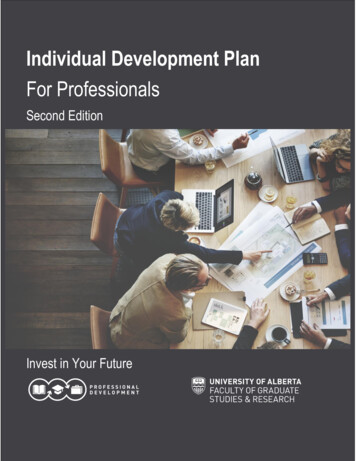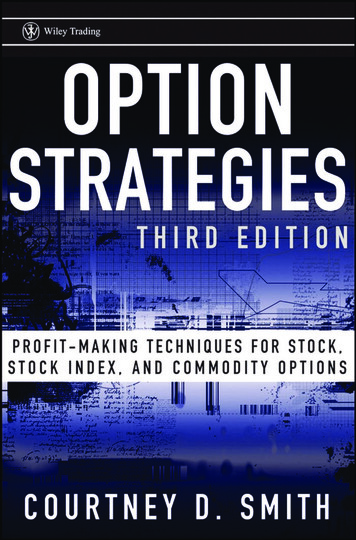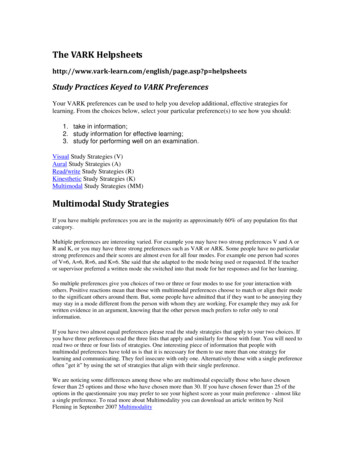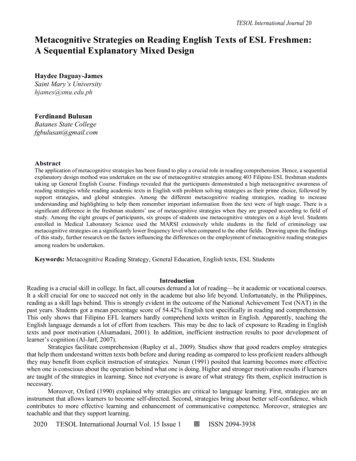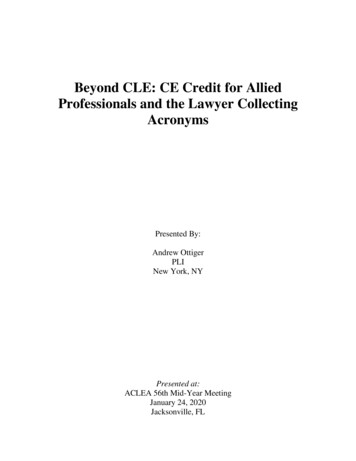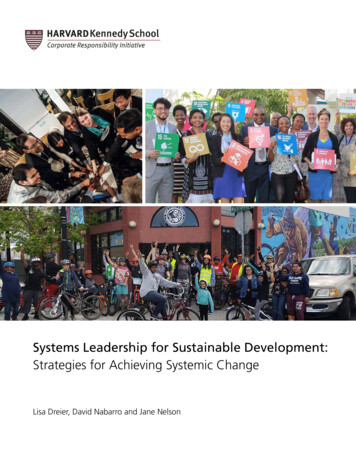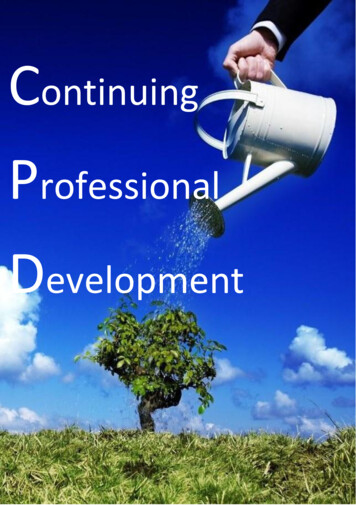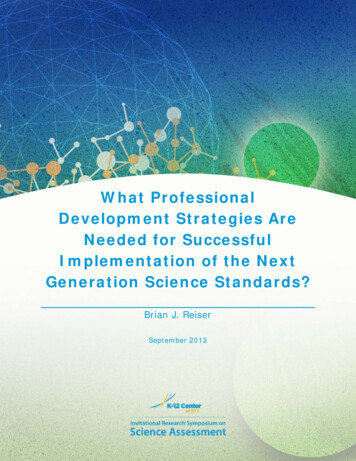
Transcription
What ProfessionalDevelopment Strategies AreNeeded for SuccessfulImplementation of the NextGeneration Science Standards?Brian J. ReiserSeptember 2013
What Professional Development Strategies Are Needed forSuccessful Implementation of the Next Generation ScienceStandards?Brian J. ReiserLearning Sciences, Northwestern UniversityIntroduction: The Central Role for Professional Development in Implementing NGSSThe new vision for science learning and teaching established in the Framework for K-12 ScienceEducation (National Research Council, 2012) and carried forward in the Next Generation ScienceStandards (NGSS; NGSS Lead States, 2013) requires a dramatic departure from approaches to teachingand learning science occurring today in most science classrooms K-12 (Banilower et al., 2013). Thisapproach to teaching and learning builds on decades of research identifying problems with scienceclassroom learning and promising strategies for what is needed to make learning more meaningful andeffective for students (National Research Council, 2007). Central to the vision of teaching and learningarticulated in the Framework and NGSS are three interrelated goals that affect how teachers need tosupport student learning:1. Core Ideas: The Framework and NGSS shift the emphasis away from the breadth of toomuch content to a focus on the in-depth development of core explanatory ideas.2. Practices: The Framework and NGSS outline a central role for science and engineeringpractices in which students develop key explanatory ideas and models throughinvestigation and apply them to make sense of phenomena.3. Coherence: Building explanatory ideas requires treating science learning as a coherentprogression in which learners build ideas across time and between science disciplines.The shifts in teaching practice required to achieve these goals are generally recognized to besubstantial (National Research Council, 2012; Wilson, 2013). Tools including new curriculum materialsand new assessments will be important supports to help the K-12 system move in these directions, butwithout a strong focus on aligned professional development, adopting NGSS and providing theseresources will not be sufficient. Supporting students in the type of coherent sensemaking sciencepractices called for the in Framework and NGSS requires a change in teachers’ daily practices. Theseshifts in practice cannot be accomplished by learning about NGSS, or by developing a collection of2
isolated techniques. Instead it requires fundamental attention to what we now know about how tosupport teachers changing their practice.To identify a professional development agenda, we begin in Section 2 with an analysis of howthe Framework and NGSS demand real change in K-12 classrooms, exploring the three issues of coreideas, practices and coherence. We identify the central shifts in teaching practices on whichprofessional development must focus if NGSS is to be successful. Then in Section 3, we review theimplications of research on professional development, particularly in systemic attempts to changeteaching practice, for teaching learning and teacher change of this sort, and consider how an effectivePD system could support teaching change aligned with the Framework and NGSS.What Demands on Teacher Learning Do the Framework and NGSS Create?There are three areas of contrast between much current practice and the approaches toteaching and learning articulated in the framework and NGSS. These concern the kind of ideas we targetfor K-12 education (explanatory core ideas), how they are built (practices), and how they need to fittogether (coherence). Each of these has implications for important shifts in teacher knowledge andpractices. For each of these three contrasts, we consider how the Framework and NGSS build on priorreforms and extend them in substantial ways. Then we consider the shifts that are needed in teachingpractices to support these changes, and the changes in beliefs, attitudes, and understanding thatunderlie these practices.A Focus on Disciplinary Core IdeasTeaching shift: The goal of instruction needs to shift from facts to explaining phenomena. Thisrefocusing of goals for learning has real implications for what teachers need to do in helping studentsdevelop ideas. For example, consider a topic present in all middle school and high school sciencetextbooks – cells. In middle school, students typically learn that all living things are composed of cells,and often learn the parts of the cell and the functions that each accomplishes. Yet these ideas, whileimportant science in the right context, if learned as facts and definitions, are not linked to the importantdisciplinary ideas that help students explain the world. Knowing the names of the parts of cells andbeing told the function of each part does not help students build a coherent model that explains howcells get the materials they need to live. It does not explain the role that cells play in multicellularorganisms, or why indeed, animals and plants need their cells to accomplish what the organism as awhole needs to survive.While there is no disagreement between prior standards and NGSS that cells are a key part oflearning biology, there is a real difference in how cells, like other ideas, are treated. The discipline of lifesciences has identified cell structure and function as an important idea, so this is part of traditionalcurricula and the 1990s standards. Yet too often, students don’t know why they are learning about cells,other than that “it’s part of learning science” (Kesidou & Roseman, 2002). Students are not using the3
ideas to explain – to make sense of phenomena. Instead students are provided the idea of cells, aregiven the parts, are told their functions, and need to learn these ideas.Contrast this with the approach outlined in the Framework and implemented in NGSS. The goalis to figure out how the structures of living things enable them to accomplish what they need to live(sub-idea LS1.A within LS1). As part of this investigation, students could learn about the parts livingthings are made of, and ask how these cells contribute to what living things need to survive. In NGSS,students are expected to be able to provide evidence to support the claim that living things are made ofcells (NGSS, MS-LS1-1) and argue from evidence how cells work within a system to enable the livingorganism to achieve its needs (NGSS, MS-LS1-3), e.g., develop an evidence-based argument for whyanimals need cells.This requires teachers and textbooks not to simply present facts and definitions as ends inthemselves, but rather to help students continually work toward explanatory models, developing theseideas from evidence (Lehrer & Schauble, 2006). This requires a shift from learning about scientific ideassuch as cells to figuring out scientific ideas that explain how and why phenomena occur (Passmore &Svoboda, 2012), e.g., how cells help organisms survive. Teachers need to see targets of learning such ascells as explanations for phenomena, and need to enact lessons in which they help students develop,test, and refine these explanatory ideas. This focus on developing explanations poses challenges forteachers in how to motivate lessons through phenomena that need to be explained, how to helplearners develop these explanations, and tie them to the phenomena and questions that motivatedthem.The Central Role of Science Engineering PracticesAll NGSS standards are defined using science and engineering practices. A second keydifference of the Framework and NGSS from prior approaches to science teaching and learning is in thefocus on practices. The science and engineering practices reflect this commitment to “figuring out,” andcharacterize how learners build knowledge by posing questions, designing investigations, buildingexplanations and models of findings, and engaging in argumentation to conduct principled comparisonsof competing ideas and reach consensus.The Framework and NGSS build on the efforts of the reforms of the last several decades thathave attempted to make inquiry a more central part of how students learn science (Deboer, 2006).Indeed, the 1990s National Science Education Standards (NSES) emphasized inquiry as central to howstudents should learn science (National Research Council, 1996) and the AAAS Benchmarks includedstandards on habits of mind that specified ways of thinking scientifically (AAAS, 1993). However in bothof these systems of standards, inquiry standards were separate from content standards. As the NSESand Benchmarks were implemented in various state standards, the content standards were the primaryfocus for curriculum frameworks, instructional materials, and assessments (*refs*). Indeed, theemphasis on inquiry was often understood to correspond to the idea of observing science ideas in4
action, equated with the idea of “hands-on science,” but the sensemaking aspects of developingexplanations were rarely emphasized (Spillane & Callahan, 2000).The characterization of science and engineering practices builds on these earlier notions ofinquiry to characterize a coherent system of activity, undergirded by common goals, expectations, andnorms that govern how to do the work and define how progress in the discipline is made (Ford &Forman, 2006; Lehrer & Schauble, 2006; National Research Council, 2007, 2012). The science andengineering practices incorporate much of what has been thought of as inquiry, but elaborate how toengage in the work of inquiry, and how this work is part of building knowledge. The eight science andengineering practices in the framework and NGSS emphasize aspects often missing from these earlierinterpretations of inquiry in classrooms. First, it emphasizes the knowledge building aspects of thescience endeavor. Science is more than testing particular hypotheses to support or disconfirm them. Thegoal of science is using the evidence of these empirical tests to tease apart and refine explanatoryaccounts, and push toward generalizability of the ideas. The vision of science as practice emphasizes aconnected system of practice that incrementally develops and refines knowledge as explanatory models(Lehrer & Schauble, 2006). Emphasizing the development of models focuses students on the coherenceof the activity, moving from questions to empirical tests to explanatory models (Passmore & Svoboda,2012; Stewart, Cartier, & Passmore, 2005; Windschitl, Thompson, & Braaten, 2008). The Framework andNGSS practices explicitly include elements of constructing explanations and developing general modelsthat can be applied to a range of phenomena to explain how and why they occur.A second clarification in the move from the narrower common conception of inquiry is theimportance of social interaction and discourse in developing these explanatory ideas (Berland &Hammer, 2012; Duschl, 2008; National Research Council, 2007; Windschitl et al., 2008). The Frameworkand NGSS practices recognize that the process of developing explanatory accounts often requiresprincipled ways to evaluate the success of an explanatory idea, and requires ways to adjudicatecompeting ideas. Hence the practice of argumentation from evidence is a key element in developingexplanations and models. The articulation of the practices in the Framework and NGSS explicitlyacknowledge that there are disciplinary approaches to argumentation that guide the knowledge buildingprocess in principled ways. The practices make explicit that the work of building, testing and refiningknowledge is realized through scientific discourse and work with scientific representations and tools.Thus, the idea of engaging in discourse and working with others to reach consensus is an explicitelement of the practices.These two ideas are captured in Figure 1. The figure shows the knowledge building aspects ofthe practices on the right (developing explanations and solutions, leading to theories and models) andthe way these knowledge products are derived from and guide investigation of the “real world” (thenatural and designed world), on the left of the figure. The aspects typically captured by the narrowerconception of inquiry realized in classrooms, primarily developing and testing hypotheses against data,are marked “Inquiry” in the figure. The use of empirical results not only to confirm hypotheses, but to5
develop explanatory accounts is indicated by the “Emphasis on Knowledge Building” as part of thedevelopment of theories and models. The role of social interaction and discourse is indicated in theargumentation practices that mediate between the knowledge and the real world.Figure 1. The shift from inquiry to science and engineering practices.Adapted from A Framework for K-12 Science Education: Practices, Crosscutting Concepts, and CoreIdeas, by the National Research Council, 2012, Figure 3-1, Washington, DC: National Academies Press.The central role of practices in the Framework and NGSS is immediately apparent in the waystandards are articulated. Rather than separate learning goals, the practices are used as a component ofeach and every standard in NGSS. The specific targets of science learning are not defined, as they havebeen for two decades, as the combination of a set of science ideas, and a set of inquiry skills. Suchdefinitions leave open a focus on a plethora of disconnected facts, rather than a central set ofexplanatory ideas people can apply to make sense of the world. In NGSS, each science target is definedas a performance expectation that reflects a science or engineering practice developing or using scienceideas (disciplinary core idea and crosscutting concept). Rather than simply knowing the fact that all livingthings are made of cells, a performance expectation in NGSS states that students should be able to“conduct an investigation to provide evidence that living things are made of cells” (NGSS, MS-LS1-1) andshould be able to “develop and use a model to describe the function of a cell as a whole and ways partsof cells contribute to that function” (NGSS, MS-LS1-2). Developing and using a model pushes for morethan knowledge of what the cell parts are called or what functions are associated with each part; itrequires that students be able to construct a causal account that specifies how each part fits processes6
that obtain and transform resources from the cell’s environment to enable the cell to function. Thus, thenames of parts of the cell or identifying functions by name are no longer acceptable learning goals inand of themselves, unless these are part of developing and using ideas to argue from evidence or todevelop and use a model to explain phenomena.Teaching shift: Inquiry is not a separate activity—all science learning should involve engagingin practices to build and use knowledge. The teaching shift needed to teach with science practicesaligns with the goals of developing explanatory knowledge. From a learning perspective, the way todevelop robust flexible knowledge is to build that knowledge as part of applying it to solve problems andquestions about the world (Edelson, 2001; Edelson & Reiser, 2006). If we want students to be able touse explanatory ideas about how living systems work to understand the world around them and to makedecisions about nutrition, health, and medical policies, learning information by being told is anineffective strategy (National Research Council, 2007, 2012).Yet most science classrooms do not engage learners in investigating and explaining (Baniloweret al., 2013; Schmidt et al., 2001; Weiss, Pasley, Smith, Banilower, & Heck, 2003). Many classroomsinvolve textbooks and teaching that present students with the ideas and use observations, experiments,and simulations so that students can observe what they have already been taught. The idea of helpingstudents develop explanatory ideas through investigating phenomena, and incrementally build andrefine ideas across time is a major shift for many teachers of science (Windschitl et al., 2008). Manyteachers need to develop pedagogical approaches to support students in science practices such asargumentation and developing explanatory models (Jimenenez-Aleixandre, Rodriguez, & Duschl, 2000;Windschitl et al., 2008). Teachers also need support learning to orchestrate the classroom discussionsthat enact these practices (Alozie, Moje, & Krajcik, 2010; Michaels, O’Connor, & Resnick, 2008).One challenging aspects of supporting practices is understanding how the practices worktogether. Although NGSS is developed using eight practices, these are identified to specify the differenttypes of activity that need to work together to build, test, and refine knowledge. In fact, these eightpractices constitute a single system of sensemaking. The practices need to work together to becoherent. While instructional situations may foreground one part of the process, or emphasize students’role in that part of the process, these practices draw their meaning from working together. For example,if students are going to argue from evidence, there needs to be a question they are trying to resolvethrough that argument. Thus at some point the students must have either developed or bought into aquestion for investigation. Evidence needs to arise from investigation.Thus, although NGSS is represented as a collection of performance expectations, it is notproductive to view these as isolated or modular learning goals. Teachers need to shift their mindsettoward viewing instruction as building a coherent storyline, in which questions are grounded onphenomena, leading to investigations, and students develop models through argumentation, and refinethose models through new phenomena that challenge existing models. The shift here is from adisciplinary organization, in which the discipline provides the breakdown an ordering of ideas, to7
organizing around the sensemaking activity. This shift poses challenges for teachers that are fartherreaching than what is apparent on first perusal of the standards. Yes teachers need to learn to supportstudents in argumentation, if they are not currently involved in supporting students in these practices.But doing so requires more than learning particular techniques to support this single practice of helpingstudents learn to support claims with evidence. In meaningful scientific argumentation, the claims aresteps toward developing explanatory models, and are constructed by interpreting evidence frominvestigations. Thus, organizing teaching around practices has implications not only for the specificactivities students will be doing, but for the basic rules about how we motivate lessons and how lessonsneed to fit together. This represents not only learning new instructional moves, but represents for manyteachers a shift in how they approach what it means for students to learn science, what counts asdeveloping an answer to a science question, and for the types of assessments that are meaningfulindicators of this learning.Coherence in Building Ideas Across TimeThe argument for coherence draws on converging strands of research. First there is therecognition that a contrast between U.S. curriculum, standards, and classroom practices and those ofother countries more successful in science reveal that our classrooms treat too many topics, toosuperficially, and in too disconnected a matter (Schmidt et al., 2001; Schmidt et al., 1996; Schmidt,Raizen, Britton, Bianchi, & Wolfe, 1997). Consistent with this comparison, there are clear argumentsfrom learning research that developing and revisiting idea in greater depth across time is a moreeffective learning strategy (Corcoran, Mosher, & Rogat, 2009; National Research Council, 2007)NGSS articulates how ideas should build across time and between science disciplines. Thereare several related aspects of coherence emphasized in the Framework and NGSS. The commitment inthe Framework and NGSS is to articulating how ideas should build on earlier ideas. Within discipline, thismeans articulating the disciplinary core ideas as progressions, in which more sophisticated versions ofthe central science ideas are built iteratively across time. Indeed, each disciplinary core idea isrepresented in increasing sophistication across multiple grade bands. There is a K-2 version of theexplanation, a 3-5 version, 6-8 and 9-12 answer to the same question. Each version goes deeper,drawing on what has been figured out in that discipline (e.g., life science, physical science, earth andspace science) in prior grade bands. However each grade band results in a coherent explanatory modelthat is a satisfying answer to part of the question. Figure 2 shows an example of how the explanation forone of the life sciences ideas (LS1.C), How do organisms obtain and use the matter and energy they needto live and grow?, is built across time. The figure summarizes the explanation built at each grade level. Ineach grade band, students develop a coherent explanation, supported by evidence, convincing as far asit goes, but with some aspects unexplained or black-boxed that can be opened up in the next gradeband.8
These explanatory models also need to build on ideas across the science disciplines. Thus, forthis biology idea, explanations at each level rely on what students have figured out about the nature ofmatter (how it cannot be created or destroyed) and how energy can be converted and transferred in asystem, disciplinary core ideas from the physical science strand. Indeed, the phenomenon to beexplained in middle school is only problematic, requiring an explanation, because ideas about energyand matter are brought in from physical science. It is because students have figured out that energycannot be created or destroyed, in combination with the earlier idea that food provides us with energy,that creates the mystery to be explained—what happens in the body that allows us to “get energy” outof the food? Given what students have learned about transfer and transformation of energy, there mustbe some process that transforms the energy and transfers it to the system that can use it. Thus, theneed for the explanation arises from this knowledge from the physical science strand. Without thoseunderstandings, there is nothing puzzling about how we get energy from food. The explanation to beconstructed, then relies on knowledge about chemical reactions and their role in rearranging matter andenabling energy conversion to achieve a critical step in the argument for this biology question.Figure 2. Building ideas across time, and between science disciplines for the life sciences idea LS1.C.(Connections to physical science ideas are underlined.)9
Teaching Shift: Teaching involves building a coherent storyline across time. Treating learningas building coherent explanations, combined with the commitment to building knowledge throughscience practices, has important implications for how teachers need to approach science teaching. Theteaching needs to be oriented toward helping student develop these coherent explanations. This meansthat explanations need to be grounded on phenomena that raise questions, and need to be justifiedbased on argument that ties in what students have figured out so far and is supported by the evidencethey have collected. In the traditional approach, when presenting a coherent explanation, teachers mayfocus on helping student understand how the pieces fit together. While this is likely a productive step,helping students construct such an explanation needs to go further. It requires introducing phenomenathat can raise questions, uncovering problems with existing explanations students may have, andhelping tease apart competing explanations through argument.Traditional curriculum materials are typically organized according to the logic of the discipline.Teachers may introduce the next topic to be addressed by referencing its role in a larger set of issues.For example, most middle school textbooks introduce the study of body systems by introducing the goalof understanding how the human body functions, explaining that it is organized in systems (circulatory,respiratory, etc.) then introduce each body system as the next to be addressed, addressing multiplelevels of organization (organs, tissues, cells) within each system. In contrast, to fully involve students inscience practice, the class needs to be attempting to explain some phenomenon that requires using theidea to explain it. One such phenomenon is the various kinds of work that the human body can do, bothinternal (heart beating, breathing), and external (kicking, moving, pushing objects). The phenomena,combined with what students already know about how actions like this require energy, motivatesquestions about how that occurs. Students have already developed the idea that food can providematerials and energy for living things, but now are pushed to consider how this can happen. This maylead to recognizing or discovering empirically other relevant phenomena, e.g., that when we engage invigorous exercise, we breathe much faster and our heart rate increases. Students also know that if theyhaven’t eaten for some time, they may feel tired and sluggish. Why do these phenomena occur? What isgoing on inside the body that leads to these effects? As students work on investigations and constructexplanations, new questions arise and motivate the next lesson, rather than the disciplinary structurewhich says to learn about body systems one should learn systems x, y, and z.This focus on explanations poses new challenges for teachers in how to motivate lessons.Although the teacher and the curriculum know that the goal is to address the important human bodysystems, if the class is engaged in science practices, there needs to be a reason to look at the nextsystem, or the next level within the body system. The answer to why we are studying heart cells todayshould no longer be “because that’s part of the body system which is next in our list of chapters” butneeds to be part of figuring out, based on evidence, how some phenomenon works. In many classrooms,although students may be told where the lesson is going, e.g., “our goal is to understand how heart cellsare different from bone cells,” that is quite different from understanding how what is being investigated10
helps address a question that students have developed and have bought into (Edelson, 2001; Kanter,2010). Learners should see the significance of ideas as they build and apply them, for making sense ofthe world, rather than being promised “you’ll need this next year.” Indeed, motivating the next topicand tying back to overarching questions is challenging for many teachers even when they explicitly takeon this goal as part of their teaching (Rivet & Krajcik, 2008; Schneider, Krajcik, & Blumenfeld, 2005).Summary of Shifts in Teacher Knowledge and PracticeTaken together, the shifts motivated by the Framework and NGSS are substantial. They reflect asystematic shift in how teachers need to think about how to motivate lessons and support students’sensemaking in investigations. Yet we know that these approaches are feasible for teachers to develop,and are productive for student learning when they do so (National Research Council, 2007).Several themes have emerged from this analysis that may pose challenges for many teachers: Lessons should be structured so that the work is driven by questions arising fromphenomena, rather than topics sequentially pursued according to the traditionalbreakdown of lessons.The goal of investigations is to guide construction of explanatory models rather thansimply testing hypotheses.Answers to science investigations are more than whether and how two variables arerelated, but need to help construct an explanatory account.Students should see what they are working on as answering explanatory questionsrather than learning the next assigned topic.A large part of the teachers’ role is to support the knowledge building aspects ofpractices, not just the procedural skills in doing experiments.Extensive class focus needs to be devoted to argumentation and reaching consensusabout ideas, rather than having textbooks and teachers present ideas to students.Teachers need to build a classroom culture that can support these practices, wherestudents are motivated to figure out rather than learning what they are told, where theyexpect some responsibility for this work of figuring out rather than waiting for answers,and where they expect to work with and learn with their peers.It is clear from this analysis that curriculum materials and assessments that reflect NGSS-alignedapproaches, by themselves will not be enough, unless teachers can support the students’ sciencepractices as targeted in NGSS-aligned curriculum materials and assessments. Yet, piecemeal changesand learning new isolated techniques will not be enough. This new vision represents substantial changesin how teachers engage in the practices of science teaching. Many teachers will need extensive support,not just in learning about NGSS, but in learning, trying out, and getting feedback on what it means toteach with this vision.11
In the next section we consider what prior studies of professional development reveal abouthow to support the change in beliefs and practices required by NGSS.What Does Research on Professional Development Suggest for Supporting theFramework and NGSS?What Makes Professional Development EffectiveProfessional development (PD) for science in the U.S. does not currently reflect a coherentapproach. Indeed Wilson (2013) suggests that “the U.S. PD system is a carnival of options.” Research oneffective professional development faces many challenges, including the rarity of programs that devotesufficient duration, attention to problems of practice, active participation, and institutional support forimplementing what is being learned (Wilson, 2013). In addition, given the systematic nature ofinterventions needed t
Education (National Research Council, 2012) and carried forward in the Next Generation Science Standards (NGSS; NGSS Lead States, 2013) requires a dramatic departure from approaches to teaching and learning science occurring today in most science classrooms



